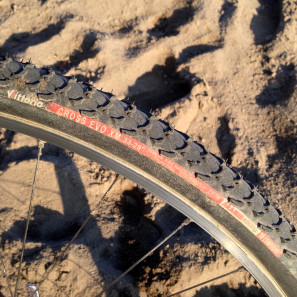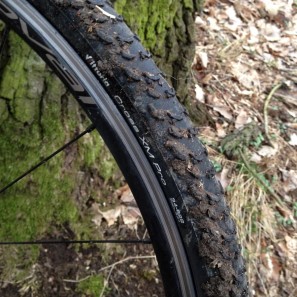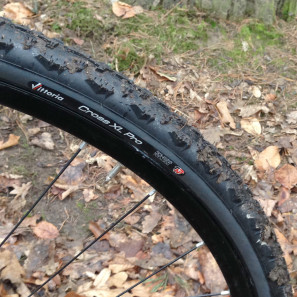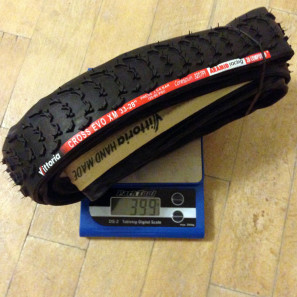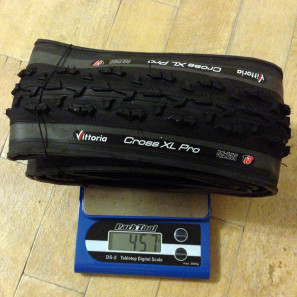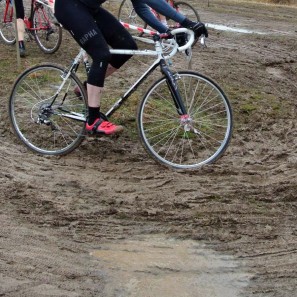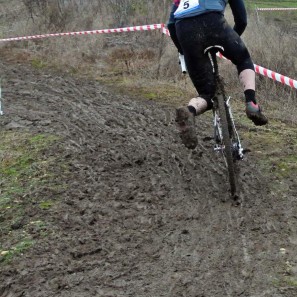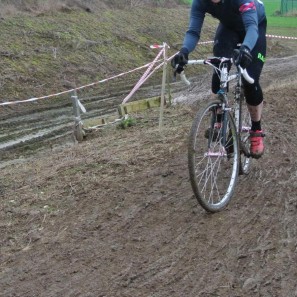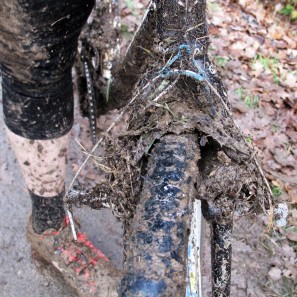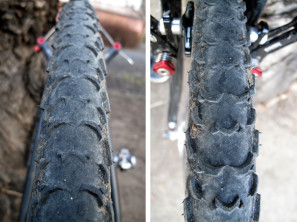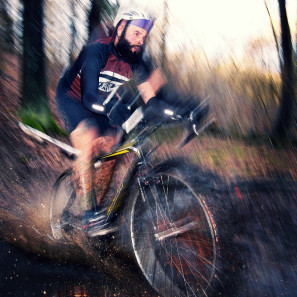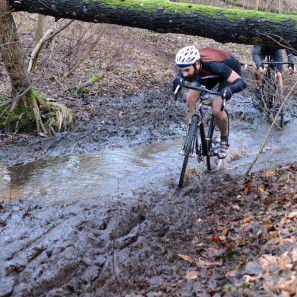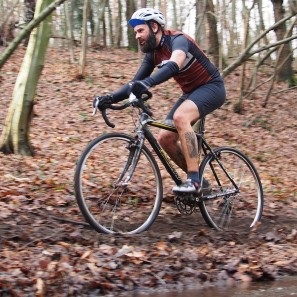We’ve ridden Vittoria tires on the road for a long time, and had pretty good luck with some of their Geax line of mountain tires (recently rolled back under the Vittoria name), but hadn’t really had a chance to spend much time on their cyclocross tires. In talking with Vittoria about our season of European Cyclocross testing, they suggested we try a set of their tubulars, plus a tubeless set. After racing the EVO XM tubulars for a bit, one of our testers threw a set on the Pro version clinchers that he had bought into our pool, so we could do some back-to-back testing of them, on and off the cross course. We ran into a few hiccups setting the XL Pros up tubeless earlier in the season (to no fault of Vittoria, really) so didn’t really get to ride them tubeless until after most of the races had passed. But we had plenty of wet and muddy cross riding to do, so got a pretty good sense of both of these wet weather treads.
Slide on past the break to see what we thought and see where each of these tires really excels….
Tech Details & Actual Weights
The widely spaced open XM tread (Vittoria’s third cross tire), designed for mud, has been in the product line for several years, and is offered in both the EVO tubular and the Pro clincher. The thin side-to-side paddle-like tread blocks are spaced almost 1cm apart to prevent mud build-up and are only 1.5-2mm high, but transition to more regularly-spaced shoulder knobs for cornering stability.
Our 33mm sample EVO tubulars weighed in at 399g a piece and 90€. The XM comes in 31 and 33mm 320tpi tubulars and in 31 and 33mm 150tpi clinchers.
The XL on the other hand was a new design last year also intended for wet and muddy terrain, but with a much more aggressive and dense tread pattern that promised to be longer wearing. The XL tread blocks are much more massive (about twice as wide and 50% higher than the XM) and made up of arrows aligned with the direction of travel. The TNT tires we tested, like most tubeless tires, have a very tight fitting bead without much stretch to it and sidewalls that felt noticeably stiff both in hand and when mounted.
The 33mm TNT Pro clinchers we had on test weighed 457g and retail for 45€. The XL is available in 31 and 33mm 320tpi tubulars, in 31 and 33mm 150tpi clinchers, and in a 33mm TNT tubeless clincher.
Casing and Tread Reviews


Photos courtesy of Zdenek Eminger
Setup of the XM tubulars and clinchers were all pretty straight forward. The tubulars were easy to stretch and glued on nice and straight without any hassle. The Corespun 320tpi cotton casing of the EVO tubulars lent a excellent ride quality anywhere between 25-35psi, and deformed predictably at especially low pressures. Since we don’t often get a chance to race the same tread back-to-back on top-end tubulars vs. standard clinchers it is easy to underestimate the difference in performance, even if the marketing bangs it over our heads. But with hot laps on the XMs, it was almost shocking how many loose sandy run-ups and slick off-camber turns went from being unridable to being a breeze. The supple casing and resulting low pressure of the tubulars makes all the difference in extra grip. Many people worry about the hassle of gluing tubulars and have a fear of flatting an expensive tire, but don’t forget that with a handmade sew-up you can always go old school, pull a punctured tubular off at home, and open the tires up to patch the latex tube inside. The tubular can be more work in setup, but the ride is unbeatable.
Along the same lines, the standard casing, folding bead clinchers went on easy and never posed a problem. Their nylon sidewalls didn’t have an overly supple feel, but did their job well enough that we didn’t have to think about them much.
Much like the XM TNTs we tested a year and a half ago, the XL tubeless clinchers were a bit more work. The large squarish tubeless-specific bead was difficult to stretch over the rim on all of the tubeless compatible wheelsets we tried (2 cross specific and 1 mtb set), but were able to install them with just one plastic tire lever. Seating the tires was also difficult, but could generally be done with a floor pump when we used a strap to compress the tire around its full circumference. The problem was that the bead diameter is sufficiently small that we had to pump the tires up to the max recommended 95psi before the beads would fully snap into their seat. What this meant was that up until that pressure, there was still air leaking, complicating installation with all but the highest volume floor pumps. Ultimately though, once seated, we were able to drop the pressure down and comfortably ride around 30psi to take advantage of the tubeless setup. A tight fit is good when you want low tubeless pressures, but don’t think installing these tires will be a breeze, even on new rims.
Since both tire designs were intended to wet and loose conditions, that’s what we tried them on for the most part. We raced through incredibly greasy mud and clay, sticky mud and grass, and deep rich forest mud. The tires spent a lot of time riding through standing water, as well as one race that had five creek crossings per lap. We also had a chance to race the tubulars at a course held at a sand quarry though extended kms of deep, soft sand. The clinchers were also tested out on some of the drier mixed-terrain races in the middle of our season, and got a lot of time in as training and general purpose trail riding tires. For our long-term testing, maybe 80% of our racing was on the EVO XM tubulars in all conditions. The XM Pro clinchers made up about 75% of the non-race riding; with the XL Pro clinchers serving mostly as damp and wet condition trail tires.
The XM tire really stands out in the openness of its design, and the lack of a prominent tread pattern down the center of the tire. Combined with very thin individual blocks, the resulting paddle-like treads are very flexible and give a lot of straight-line traction in loose conditions. Traction in deep sand was a pleasant surprise reminding me of desert paddle motorcycle tires, while cornering in sand was still a bit unpredictable but no worse than any other tire we’ve tried.
The greatest benefit of the open XM design is its self-clearing. Mud just does not hold onto the center of the tire, as the tread is cleaned almost immediately. They cleared especially well in slick mud, and when grass would normally pack into a tire. They still pick up the mud and grass and throw it (pack it) onto the frame and fork, but at least the tire stays clean to keep powering you through the slop. The tires aren’t magic though; when the mud was thin and especially slick we still slid all over the place and found that the transition from the center-to-side knobs wasn’t always smooth.
But all their traction came at the expense of center knobs that wore down quickly. While our tubulars were mostly race-only and only ended up with a couple hundred kilometers on them over the season, the rear clincher was pretty much worn out after about 550km of mixed riding, including asphalt and gravel to-and-from rocky, rooted trail riding. The front tire has noticeable wear yet still does its job well; the rear on the other hand has essentially worn every other center knob smooth, making the tire sketchy to ride on even damp trails. Thankfully, the side knobs are more densely packed and therefore wore down more slowly so cornering and off camber traction didn’t really diminish too much. In any case, after one full season of riding one tire needs to be replaced.
The TNT XL Pros only have a couple of hundred kms on them so far and show no sign of wear yet. We will keep riding them and see how they stand up, but from our initial impressions their tread design looks like it will last many times longer than the XM. The more aggressive tread gave us the confidence of a mountain bike riding trails on the cross bike. Their toothy profile dug into the wet soil of late winter and railed damp hardpack turns as far as we were willing to push it. On loose trails they rode really well at very low pressures, but once back on the road the low pressure felt like the tire was constantly twisting and folding under our efforts, and really wanted another 10psi. We haven’t had them on dry trails yet, but they have given us confidence on everything we’ve tried so far.
Final Thoughts


Photos courtesy of Absurd Crew, MadCyborg & Ersatzspeiche
I wouldn’t really recommend using the XM Pro tires as a universal solution, as one of our testers did, riding every type of surface. They really shine on damp to wet surfaces, and improve greatly with lower and lower pressures (maybe more so compared to other tubular/clincher options we’ve tried.) With the higher pressures needed with a clincher, the tire’s contact patch engages less of the side knobs, and yields a tire that does not grip dry or loose-over-hard surfaces at all. This might make a TNT version appealing for the XM, but sadly Vittoria doesn’t offer one.
Along the same lines, the EVO XM tubulars were excellent on damp terrain and in heavy mud, but quite condition-specific. There is no disputing the ride quality of high thread count tubulars. If you frequently race on wet cross courses, these tires perform very well. But if you don’t usually find water and muddy ruts at your races, you’d be better looking to a more multi-purpose tread.
Lastly, the XL Pros seem to offer a bit more versatility, although at lower tubeless pressures the extra traction definitely means slower rolling. With their stiff TNT sidewalls we happily ran them down around 30psi for excellent traction, but when we hit the gravel and then asphalt for the ride home it felt like we both had a killer headwind and a flat tire at the same time. My suggestion is carry a good pump and adjust on the fly for the best experience.
All three pairs of tires suit wet trails well. Go XM if you are worried about mud build-up; go XL if it won’t be only mud. Go tubular if you want to race or are serious about ride quality; go TNT tubeless for trail riding; or go for the regular clincher if you can’t be bothered. In any case, you’ve got options.
